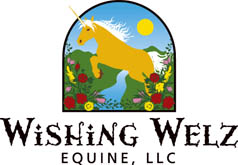Highlights from the Tucson Clinics
Pete Ramey, Dr. Robert Bowker, and EasyCare Inc.
by Yvonne Welz ©2007, from Issue 26 of The Horse's Hoof Magazine
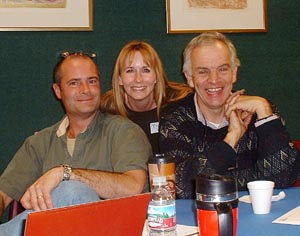
Yvonne Welz with Pete Ramey (left) and Dr. Robert Bowker (right).
Snow actually fell in Tucson, Arizona, on January 21, 2007—but
for this enthusiastic group of hoof fanatics, that was definitely not the
biggest news of the day! James & I were lucky enough to be right in the
middle of it all, for a week of hoof care education that inspired, challenged,
and enlightened.
Clinic Summaries
EasyCare Inc. sponsored this unforgettable Tucson clinic series.
Jan. 20 & 21 was Pete Ramey's clinic, which we absolutely loved.
The days were long, but the information was stimulating and quite in tune
with our own concepts and discoveries. Pete expressed a practical, sensible,
common sense, middle-ground approach that is very similar to the place where
we find ourselves at.
There were about 150 people at Pete's clinic from all over
the country, and some from Europe; it seemed that at least half were professional
trimmers, vets or farriers, plus a large group of owner-trimmers. The atmosphere
was energetic, and the questions were often very technical. I talked to many
people who commented they felt this was the most advanced Pete Ramey clinic
they had ever attended, probably due to the advanced level of the attendees!
On Jan. 22, EasyCare provided a Hoof Boot Fitting Clinic, with
about 75 attendees. This clinic was wonderful! I talked to so many people
afterwards who were just thrilled with what they learned there. I was, too!
Jan. 23 & 24 featured Robert M. Bowker, VMD, PhD, of the Michigan State Univ. Equine Foot Laboratory, presenting his 2 day clinic for the very first time. This is when we really kicked things up a notch! The room was filled with 80 serious students of the hoof, and our brains were simply overloaded with information. Some of his material challenged us, while other parts only confirmed what we already believed. And in some cases, everything we thought we knew about the hoof was tipped upside down!
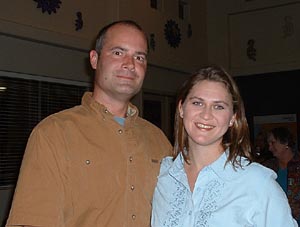
Pete Ramey and wife, Ivy. Congratulations to both on their
new baby coming in September.
Pete Ramey Clinic
I've read Pete's book and all of his articles, but nothing substitutes for hearing someone's concepts first-hand. Things that can get confusing in print often become clarified in person. One of Pete's most helpful and important concepts is paying attention to the depth of the collateral groove, as a simple tool to gauge sole thickness. On a hunch, Pete measured 8 very different hooves (sliced in vertical cross-sections) in Dr. Bowker's lab, and in every case, the distance from the bottom of the collateral groove to the corium was 7/16". This measurement will most likely apply to all hooves (except those with a false sole).
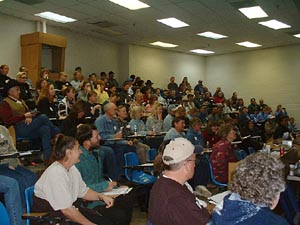
Over 150 people attended Pete Ramey’s clinic.
Keeping this measurement in mind, he suggests that an adequate
sole will lift the collateral groove off the ground by about 5/8 - 3/4".
This measurement is taken from the bottom of the collateral groove to the
ground surface of the hoof—in other words, don't measure depth of collateral
groove to bottom of sole; measure depth of collateral groove to a straight
edge laid across the hoof to simulate where the ground would be. (This takes
for granted that the hoof wall is not too long, of course). If the measurement
is less than 5/8" (either at the heel area, or apex of frog), sole should
not be removed, since it is too thin. If the measurement is more than 3/4",
sole can very safely be removed. A very helpful guideline!
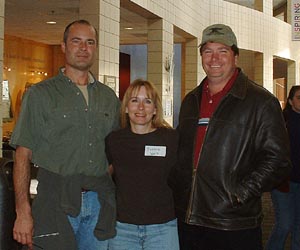
L-R: Pete Ramey, Yvonne & James Welz. Okay, I really feel short now!
Pete's clinic was brimming with great information: trimming techniques, an overview of hoof boots & boot padding, the latest research from Bowker and others, before & after trims including pathological cases, and photos of wild horse hooves, as well as very nice domestic hooves. Most of the day was spent in the classroom, with trimming demonstrations in the late afternoon.
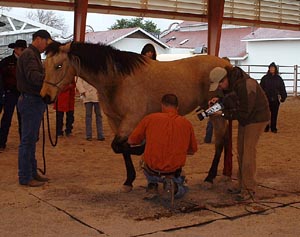
Pete trims while Ivy videotapes; participants watch the trim close-up on giant, flat screen monitors positioned around the room.
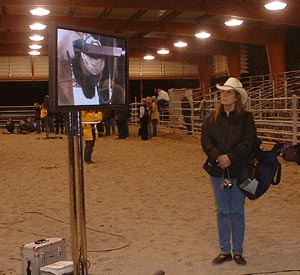
Cheryl Henderson watches trimming.
EasyCare Boot Fitting Clinic
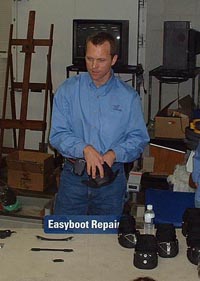
Garrett demonstrates Easyboot repair techniques.
EasyCare Inc. President Garrett Ford provided a fascinating history of the company, which Garrett purchased in 1993 from Easyboot inventor, nuclear physicist Dr. Neel Glass. The company has grown by leaps and bounds, especially since the late 90's, when the barefoot movement began to take off. We have been truly impressed with EasyCare's commitment to barefooters, and their response to our needs. Karen Chaton, a top endurance rider and EasyCare's Director of Marketing, provided a slideshow of her rides all over the country—in Easyboots, of course. We heard about the latest innovations and designs, and then broke up into groups to learn more about boot repair, the new Comfort Pad systems, and watch on-site boot fitting.
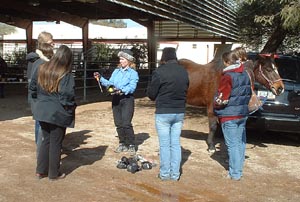
Karen Chaton demonstrates tips for fitting Epics and Bares,
including some nifty ideas using duct tape and plumber’s putty tape!
Dr. Robert Bowker Clinic
Dr. Bowker's presentation was truly ground-breaking. We all sat entranced for two full days of deep, technical, scientific hoof information. There was barely enough time to skim the surface. I took over 50 pages of hand-written notes, and I was writing as fast as I could! I certainly can't do his information justice in these few short paragraphs, but I'll provide a brief glimpse.
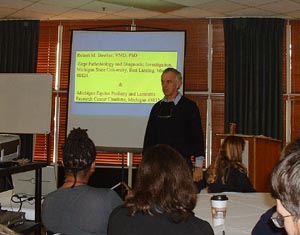
This extremely educated group of hoof enthusiasts greatly
enjoyed the brain overload of information that Dr. Bowker provided!
Throughout the two days, some of his information was so important,
I labeled it "mind-blowing." Here are a few of his mind-blowing
points:
• The hoof wall is not a rigid structure, but is fluid;
the hoof wall inside is like "peanut butter."
• All hoof wall does not grow from the coronet; a significant portion
of inner hoof wall is formed from "grocery bags" of cells in the
second epidermal laminae.
• There is improved perfusion of blood flow through the foot on pea rock,
sand or foam pads, and a dramatic decrease of perfusion on cement or wood
blocks.
• Movement is so important because it improves the perfusion of the foot.
• With peripheral loading of the hoof wall (through shoeing or trimming),
blood flow stops for a brief moment in the foot, when standing, with every
single heartbeat.
• In a good-footed horse, the entire digital cushion area is all fibrocartilage;
in a bad-footed horse, it is fatty connective tissue.
• In a good-footed horse, there is fibrocartilage directly over the bars;
in a bad-footed horse, there is simply a piece of thin, connective tissue.
• Fibrocartilage is created through stimulation—movement. Once created,
it will stay there permanently. Horses that don't move enough, don't
ever develop the fibrocartilage.
• A solar load on the hoof encourages bone to be laid down; a peripheral
load on the hoof encourages bone to be lost.
• Peripheral loading of the hoof (shod or barefoot) is a negative thing!
• A horse living outside will take 4,000-6,000 steps per 24 hr; a horse
living in a stall will take 800 steps per 24 hr.
• There is no direct connection that he can find between the hoof wall
to the coffin bone that can create support—there is simply dermal tissue
between the laminae & the coffin bone.
• The function of the laminae are not to support the horse, but rather
to produce tubules for the white line and sole.
• 4-point contact is artificial, because if these points were active,
they would be worn down and recessed.
• Increased laminae density is a sign of stress.
• Solar plug—ground material that packs in the hoof—minimizes
peripheral loading effects.
• Scooping out sole and bars accentuates peripheral loading effects.
• There is 1/3 the amount of pressure on the hoof wall when standing
on rubber vs. standing on concrete. This is because the hoof is fluid, and
there is more surface area on rubber.
• Bars should be a weight-loading structure, with a healthy bar at a
45 degree angle to the ground.
• Most of the sole comes right from the bars and is growing forward.
If bars are removed, you remove sole regeneration—bars provide keratinized
horn for the sole.
• The coffin bone is not parallel to the sole; rather it is closer to
the sole in the center.
• The thickest part of the sole is under the coffin bone.
• At least one-third of hoof wall comes from laminae (up to 50%)
• Evidence suggests that P3 is partially supported by a thick sole in
front of the bars.
Some Bowker-isms: "Peripheral Loading Device" (a horse
shoe), "Humanoid" (person), "Gooder" (really good!)
Thanks to all the folks at EasyCare, Pete & Ivy Ramey, and Dr. Robert Bowker for providing such a wonderful event. For the future of equine hoof care, this was a really "gooder" week.
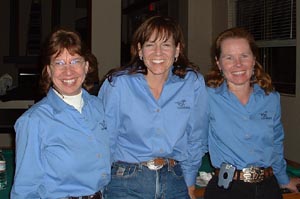
The EasyCare Girls! L-R: Cathie Hook, Debbie Schwiebert and Karen Chaton.
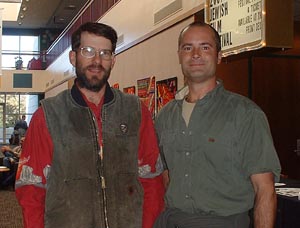
Dr. Tomas Teskey and Pete Ramey.
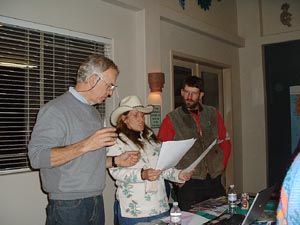
L-R: Dr. Bowker, Cheryl Henderson, and Dr. Teskey. Cheryl organized a wonderful Barbecue Party on Monday evening.
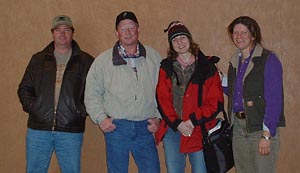
Strasser course alumni: James Welz (‘01), Dave Fitton (‘02), Betsy Merritt (‘02), and Carrie Christiansen (‘03).
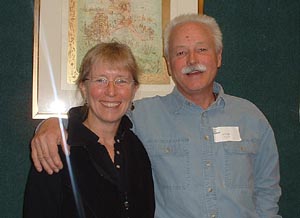
Hoofjack’s Dawn Crawford and Kevin Keeler.
